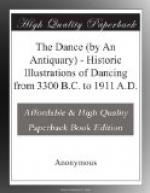“When the instrument player has ceased” continues our good Canon “make a deep bow by way of taking leave of the young lady and conduct her gently to the place whence you took her, whilst thanking her for the honour she has done you.” Another extract is not wanting in flavour: “Hold the head and body straight, have a countenance of assurance, spit and cough little, and if necessity compels you, turn your face the other side and use a beautiful white handkerchief. Talk graciously, in gentle and honest speech, neither letting your hands hang as if dead or too full of gesticulation. Be dressed cleanly and neatly ’avec la chausse bien tiree et Pescarpin propre.’
“And bear in mind these particulars.” ]
We have have seen from the fourteenth century (figs. 35 C, 36 A, 46) how common the bagpipe was in out-of-door dances; in the illustrations from Duerer (fig. 46) and in fig. 53 from Holtzer it has developed, and has two accessory pipes, besides that played by the mouth, and the player is accompanied by a sort of clarionet. This also appears to be the only accompaniment of the Trio (fig. 58). [Illustration: Fig. 50.—Morris dancers. From a window that was in the possession of George Tollett, Esq., Birtley, Staffordshire, 16th century.]
[Illustration: Fig. 51.—Court dance. From a drawing by Callot, 1635 A.D.]
In the sixteenth century certain Spanish dances were introduced into France, such as la Pavane, which was accompanied by hautboys and sackbuts.
[Illustration: Fig. 52.—Comic dancers. By Callot, from the act entitled “Balli di Sfessama,” 1609 A.D.]
[Illustration: Fig. 53.—Country dance. From a drawing by John Evangelist Holtzer, 17th century.]
[Illustration: Fig. 54.—A ball-room dance, Le Bal Pare, of the 18th century. From August de l’Aubin.]
[Illustration: Fig. 55.—A dance in the 18th century. From a painting by Hogarth.]
There were, however, various other dances of a number too considerable to describe here, also introduced. The dance of the eighteenth century from Derby ware (fig. 59) seems to be but a continuation in action of those of the sixteenth century, as out-of-door performances.
[Illustration: Fig. 56.—Caricature of a dancing master. Hogarth.]
We have now arrived at the modern style of ball, so beloved by many of the French Monarchs. Henry IV. and Napoleon were fond of giving these in grand style, and in some sort of grand style they persist even as a great social function to our own time. The Court balls of Louis XIII. and XIV. at Versailles were really gorgeous ballets, and their grandeur was astonishing; this custom was continued under the succeeding monarchs. An illustration of one in the eighteenth century by August de l’Aubin (fig. 54) sufficiently shows their character. There is nothing new in the postures illustrated, which may have originated thousands of years ago. As illustrating the popular ball of the period, the design by Hogarth (fig. 55) is an excellent contrast. The contredanse represented was originally the old country dance exported to France and returned with certain arrangements added. This is a topic we need not pursue farther, as almost every reader knows what social dancing now is.




